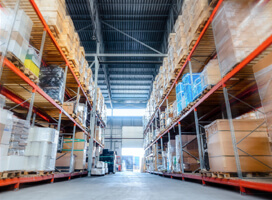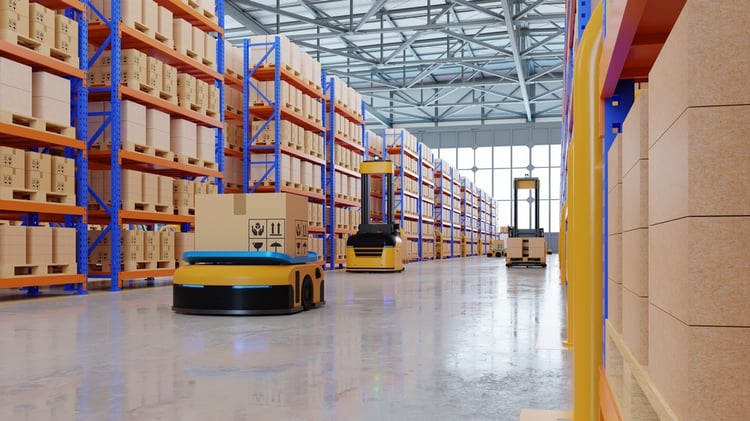
Technology has significantly advanced the logistics industry in recent years. And it couldn’t come at a better time when eCommerce sales have skyrocketed, and supply chain issues have persisted. But what if your warehouse could directly communicate low inventory or pick items for you? It might sound like the warehouse of the future, but the technology is already here. It’s called smart warehousing.
What is a Smart Warehouse?
A smart warehouse is a technology-driven warehouse that stores inventory or raw materials, using various solutions to monitor inventory and optimize warehouse processes. Unlike traditional warehouses, a smart warehouse leverages the latest technology to streamline internal processes.
Even though roughly 80% of warehouses still have no automation solutions, the rate of investment in these areas is soaring. According to Research and Markets, the market for warehouse automation technology is expected to grow to $37.6 billion by 2030. Another survey found that 27% of warehouse decision-makers plan to invest in this technology by 2024.
Benefits of Smart Warehousing
Sure, smart warehousing requires an investment of time and money. But the payoffs are worth it for most companies. Smart warehousing benefits include:
- Better productivity levels
- Improved accuracy (fewer errors)
- Reduction in overhead
- Less paperwork
- More flexibility in your hours of operation
- Supplement to your workforce requirements
- Fewer injuries
- Better insights
- Greater customer satisfaction
Top 10 Trends in Smart Warehousing to Revolutionize Your Processes
Building a smart warehouse can elevate your processes—but what are emerging as the most impactful ways to create a smart warehouse, and how can they affect your processes from end to end? Here are some of the top trends in smart warehousing that can help your business improve its receiving, storing, inventorying, and fulfilling of orders.
1. Warehouse Management Systems
The foundation of just about any smart warehouse will be its warehouse management system (WMS), which can be run locally or as a cloud-based service. Your WMS will allow you to manage all essential supply chain functions from a single system, some parts of which you can share with your partners and customers to provide more visibility.
Using a WMS should complement your other automation processes, giving you a variety of benefits:
- Optimizing your warehouse layout
- Real-time access to quality data
- Streamlined warehouse processes
- Improve inventory accuracy
- Better safety and security
- Better supplier and customer relationships
2. RFID Tags
With so many items moving in and out of your warehouse, you need the most efficient way to track them. Enter RFID tags. Short for Radio Frequency Identification, RFID uses radio wave-based technology to record and report the location of items with tags in real-time.
RFID tags are small, affordable tags that attach to assets like products or pallets. An RFID scanner can read up to 1,000 tags per second simultaneously, reporting the data to your warehouse management system. This information can be used for inventory management, order tracking, and much more.
3. Internet of Things (IoT)
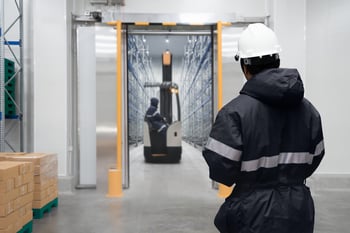 The Internet of Things (IoT) is another must-have for any smart warehouse. This consists of having sensors connected to vital machinery or assets so that you can control all the moving parts in your warehouse. For example, sensors in cold storage or throughout the warehouse allow you to monitor and control the climate to prevent product spoilage. Other sensors can tell you if a piece of machinery is operating outside established parameters, meaning it needs immediate servicing.
The Internet of Things (IoT) is another must-have for any smart warehouse. This consists of having sensors connected to vital machinery or assets so that you can control all the moving parts in your warehouse. For example, sensors in cold storage or throughout the warehouse allow you to monitor and control the climate to prevent product spoilage. Other sensors can tell you if a piece of machinery is operating outside established parameters, meaning it needs immediate servicing.
4. Wearables
Warehouse employees work in fast-paced environments subject to strict deadlines. They’re also asked to perform repetitive tasks efficiently. To be able to do this, they need to be able to move around as freely as possible with few constraints. Wearables are an excellent smart warehouse solution.
Examples of wearables include smart glasses, headsets, and even exoskeletons. Workers can wear a headset while picking to get voice commands for their next assignment. They can even confirm completion via voice to create a new record in the WMS.
5. Artificial Intelligence & Machine Learning
Artificial intelligence (AI) is the ability of a machine to gather knowledge from experiences and act on those experiences. Machine learning is the ability of a machine to perform tasks well by creating self-learning algorithms. Warehouses are using both solutions in areas like warehouse layout optimization, inventory management, staff scheduling, picking and packing processes, and more.
When you apply AI, machine learning, and data analysis together, your warehouse can leverage predictive analytics to optimize its logistics processes, better understand customer behavior, and anticipate market changes before they happen. According to a recent report from Deloitte, 31% of businesses already use predictive analytics, and that figure is expected to increase by 48% over the next five years.
6. Immersive Reality
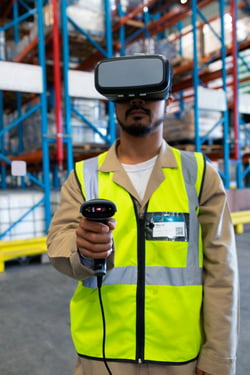 Smart warehouses are levering various immersive reality solutions, like virtual and augmented reality, to improve warehouse operations. For example, either VR or AR can be used to optimize warehouse layouts, and VR is an excellent technology for things like heavy machinery training.
Smart warehouses are levering various immersive reality solutions, like virtual and augmented reality, to improve warehouse operations. For example, either VR or AR can be used to optimize warehouse layouts, and VR is an excellent technology for things like heavy machinery training.
7. Automated Picking Tools
Picking, which is the process of locating and getting ordered items from warehouse shelves, is one of the most labor-intensive warehouse processes. It can also be inefficient and prone to errors due to the repetitive nature of the work.
Various technology solutions can automate some or all of the picking process. For example, pick-to-light, voice automated order picking, and robotic order picking are common. Using RFID tags in combination with mobile powered carts in the warehouse can also streamline the picking process.
8. Automated Guided Vehicles (AGVs)
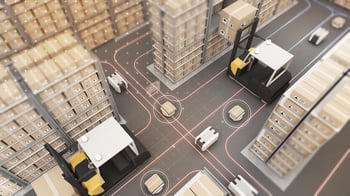 Storing and retrieving products is another area of warehouse management that is ripe for automation. Automated guide vehicles (AGVs) can perform a variety of functions, such as:
Storing and retrieving products is another area of warehouse management that is ripe for automation. Automated guide vehicles (AGVs) can perform a variety of functions, such as:
- Storing racks, pallets, or other containers
- Horizontal and vertical reel storage
- Storing pallets in warehouse racks
- Automated trailer loading and unloading
9. Collaborative Robots
Collaborative robots, or “cobots,” are fully autonomous robotic technologies that are meant to work with your existing employees, not replace them. Warehouses using cobots usually keep most of their existing infrastructure and processes but are able to optimize workflows using cobots. These solutions can be used for materials handling, such as picking, packing, and inventory management.
10. Automated Storage and Retrieval Systems (AS/RS)
Automated storage and retrieval systems have been around for decades. Examples of these are pallet lifting and lowering devices, conveyors, product retrieval machines, and warehouse control systems. These systems are durable and offer consistent performance in product handling to improve efficiency and supplement human labor.
Smart warehouses and processes are quickly becoming the norm in today’s business world, and it’s easy to see why. These facilities are equipped with advanced solutions that allow them to operate more efficiently and autonomously. By implementing smart warehousing processes, your business can streamline its operations, reduce costs, increase efficiency, and improve the overall customer experience.
